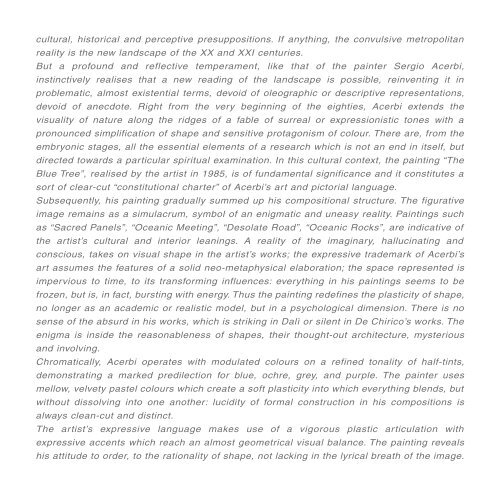Sergio Acerbi Inconsistente Durezza - Opere 2006
Sergio Acerbi Inconsistente Durezza - Opere 2006
Sergio Acerbi Inconsistente Durezza - Opere 2006
You also want an ePaper? Increase the reach of your titles
YUMPU automatically turns print PDFs into web optimized ePapers that Google loves.
cultural, historical and perceptive presuppositions. If anything, the convulsive metropolitan<br />
reality is the new landscape of the XX and XXI centuries.<br />
But a profound and reflective temperament, like that of the painter <strong>Sergio</strong> <strong>Acerbi</strong>,<br />
instinctively realises that a new reading of the landscape is possible, reinventing it in<br />
problematic, almost existential terms, devoid of oleographic or descriptive representations,<br />
devoid of anecdote. Right from the very beginning of the eighties, <strong>Acerbi</strong> extends the<br />
visuality of nature along the ridges of a fable of surreal or expressionistic tones with a<br />
pronounced simplification of shape and sensitive protagonism of colour. There are, from the<br />
embryonic stages, all the essential elements of a research which is not an end in itself, but<br />
directed towards a particular spiritual examination. In this cultural context, the painting “The<br />
Blue Tree”, realised by the artist in 1985, is of fundamental significance and it constitutes a<br />
sort of clear-cut “constitutional charter” of <strong>Acerbi</strong>’s art and pictorial language.<br />
Subsequently, his painting gradually summed up his compositional structure. The figurative<br />
image remains as a simulacrum, symbol of an enigmatic and uneasy reality. Paintings such<br />
as “Sacred Panels”, “Oceanic Meeting”, “Desolate Road”, “Oceanic Rocks”, are indicative of<br />
the artist’s cultural and interior leanings. A reality of the imaginary, hallucinating and<br />
conscious, takes on visual shape in the artist’s works; the expressive trademark of <strong>Acerbi</strong>’s<br />
art assumes the features of a solid neo-metaphysical elaboration; the space represented is<br />
impervious to time, to its transforming influences: everything in his paintings seems to be<br />
frozen, but is, in fact, bursting with energy. Thus the painting redefines the plasticity of shape,<br />
no longer as an academic or realistic model, but in a psychological dimension. There is no<br />
sense of the absurd in his works, which is striking in Dalì or silent in De Chirico’s works. The<br />
enigma is inside the reasonableness of shapes, their thought-out architecture, mysterious<br />
and involving.<br />
Chromatically, <strong>Acerbi</strong> operates with modulated colours on a refined tonality of half-tints,<br />
demonstrating a marked predilection for blue, ochre, grey, and purple. The painter uses<br />
mellow, velvety pastel colours which create a soft plasticity into which everything blends, but<br />
without dissolving into one another: lucidity of formal construction in his compositions is<br />
always clean-cut and distinct.<br />
The artist’s expressive language makes use of a vigorous plastic articulation with<br />
expressive accents which reach an almost geometrical visual balance. The painting reveals<br />
his attitude to order, to the rationality of shape, not lacking in the lyrical breath of the image.


